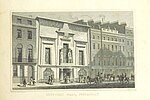The Sladmore Gallery
The Sladmore Gallery is a London art dealership with two premises, one at 32 Bruton Place off Berkeley Square (held since its foundation in 1965) and the other established at 57 Jermyn Street in 2007. Its speciality is animalier sculptors (with the Bruton Place premises specialising in contemporary sculptors and Jermyn Street specialising in 19th- and early 20th-century sculptors). Its Directors are Edward Horswell, Nona Horswell and Gerry Farrell.The Gallery has posthumously held exhibitions for Auguste Rodin, Aristide Maillol, Edgar Degas, Rembrandt Bugatti, Prince Paul Troubetzkoy and Antoine-Louis Barye. Living exhibitors at the London premises have included Mark Coreth, Geoffrey Dashwood , Sophie Dickens and Nic Fiddian-Green .The Sladmore Gallery also puts on shows and fairs in New York, Maastricht, Paris and London. The Sladmore Gallery is a member of the British Antique Dealers' Association and the Society of London Art Dealers.
Excerpt from the Wikipedia article The Sladmore Gallery (License: CC BY-SA 3.0, Authors).The Sladmore Gallery
Jermyn Street, City of Westminster Mayfair
Geographical coordinates (GPS) Address Nearby Places Show on map
Geographical coordinates (GPS)
| Latitude | Longitude |
|---|---|
| N 51.507651 ° | E -0.139267 ° |
Address
Sladmore Gallery
Jermyn Street
SW1Y 6LX City of Westminster, Mayfair
England, United Kingdom
Open on Google Maps









